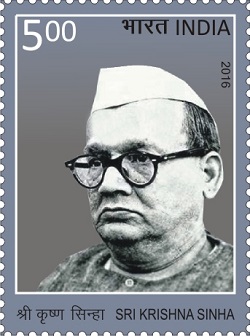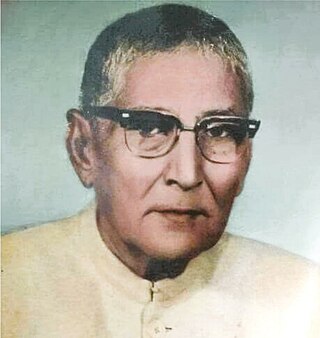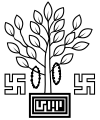Aurangabad is a city in Aurangabad District, Bihar, India. It is the district's centre of governance and has a population of 102,244 as of 2011. The people of this region speak Magahi and Hindi.

Shri Krishna Singh (Sinha) (21 October 1887 – 31 January 1961), also known as Shri Babu, was the first chief minister of the Indian state of Bihar (1946–61). Except for the period of World War II, Sinha was the chief minister of Bihar from the time of the first Congress Ministry in 1937 until his death in 1961. Along with the Desh Ratna Rajendra Prasad and Bihar Vibhuti Anugrah Narayan Sinha (A.N. Sinha), Sinha is regarded among the 'Architects of Modern Bihar'. He also led the Dalit entry into the Baidyanath Dham temple (Vaidyanath Temple, Deoghar). He was the first chief minister in the country to abolish the zamindari system. He underwent terms of imprisonment for a total of about eight years in British India. Sinha's mass meetings brought many people to hear him. He was known as Bihar Kesari for his "lionlike roars" in public speaking. His close friend and Gandhian Bihar Vibhuti A.N. Sinha in his essay Mere Shri Babu wrote that, "Since 1921, the History of Bihar has been the history of the life of Shri Babu".

Krishna Ballabh Sahay, popularly known as K B Sahay was an Indian freedom fighter, who after Indian Independence became the Revenue Minister of Bihar and then became the fourth Chief Minister of unified Bihar.

The Punjab Legislative Assembly or the Punjab Vidhan Sabha is the unicameral legislature of the state of Punjab in India. The Sixteenth Punjab Legislative Assembly was constituted in March 2022. At present, it consists of 117 members, directly elected from 117 single-seat constituencies. The tenure of the Legislative Assembly is five years unless dissolved sooner. The Speaker of the sixteenth assembly is Kultar Singh Sandhwan. The meeting place of the Legislative Assembly since 6 March 1961 is the Vidhan Bhavan in Chandigarh.

Satyendra Narayan Sinha was an Indian politician and statesman, participant in the Indian independence movement, a leading light of Jaya Prakash Narayan's ‘complete revolution’ movement during the Emergency and a former Chief Minister of Bihar. Affectionately called Chhote Saheb, he was also a seven-time Member of Parliament from the Aurangabad constituency, a three-term Member of the Bihar Legislative Assembly, and a Member of the Bihar Legislative Council once. Regarded to be one of India's most influential regional people of the time, his reputation was synonymous with being a strict disciplinarian and tough taskmaster.

Anugrah Narayan Sinha, known as Bihar Vibhuti, was an Indian nationalist statesman, participant in Champaran Satyagraha, Gandhian & one of the architects of modern Bihar, who was the first Deputy Chief Minister and the Finance Minister of the Indian state of Bihar (1946–1957). He was also a Member of the Constituent Assembly of India, which was elected to write the Constitution of India and served in its first Parliament as an independent nation. He also held a range of portfolios including Labour, Local Self Government, Public Works, Supply & Price Control, Health and Agriculture. A.N. Sinha, affectionately called Anugrah Babu, was a very close associate of Mahatma Gandhi during the freedom struggle movement and worked with Bihar Kesari Sri Krishna Sinha to lead the Gandhian movement in Bihar. One of the leading nationalists in the Indian independence movement from Bihar after Dr Rajendra Prasad, he was elected as the Congress Party deputy leader in the state assembly to assume office as first Deputy Chief Minister cum Finance Minister of independent Bihar, and re-elected when the Congress Party won Bihar's first general election with a massive mandate in 1952.
The Government of Uttar Pradesh is the subnational government of the Indian state of Uttar Pradesh with the governor as its appointed constitutional head of the state by the President of India. The Governor of Uttar Pradesh is appointed for a period of five years and appoints the Chief Minister of Uttar Pradesh and their council of ministers, who are vested with the executive powers of the state. The governor remains a ceremonial head of the state, while the chief minister and their council are responsible for day-to-day government functions.

Kishori Sinha was an Indian politician, social activist, a lifelong advocate of women's empowerment and a former two-term Member of Parliament from the Vaishali constituency. She was married to the former Chief Minister of Bihar Satyendra Narayan Sinha, who was a seven-term Member of Parliament, from the constituency of Aurangabad. Her son Nikhil Kumar had served as the Governor of Kerala and Governor of Nagaland.

The Uttar Pradesh Legislative Council also known as Uttar Pradesh Vidhan Parishad is the upper house of the bicameral legislature of Uttar Pradesh, a state in India. Uttar Pradesh is one of the six states in India, where the state legislature is bicameral, comprising two houses: the Vidhan Sabha and the Vidhan Parishad. The Vidhan Parishad is a permanent house, consisting of 100 members.
Bihar is a state situated in Eastern India. It is surrounded by West Bengal to the east, Uttar Pradesh to the west, Jharkhand to the south and Nepal to the north.

Bihar Legislative Council also known as Bihar Vidhan Parishad is the upper house of the bicameral Bihar Legislature of the state of Bihar in India.

The Bihar Legislative Assembly also known as the Bihar Vidhan Sabha is the lower house of the bicameral Bihar Legislature of the state of Bihar in India. The first state elections were held in 1952.
State governments in India are the governments ruling over 28 states and 8 union territories of India and the head of the Council of Ministers in a state is the Chief Minister. Power is divided between the Union government and state governments. While the Union government handles defence, external affairs etc., the state government deals with internal security and other state issues. Income for the Union government is from customs duty, excise tax, income tax etc., while state government income comes from sales tax (VAT), stamp duty etc.; now these have been subsumed under the various components of the Goods and Services Tax

The Bihar Legislature is the supreme legislative body of the state of Bihar. It is a bicameral legislature composed of the Governor of Bihar and two houses, The Bihar Legislative Council and The Bihar Legislative Assembly. The governor in his role as head of the legislature has full powers to summon and prorogue either house of legislature or to dissolve the Legislative Assembly. The governor can exercise these powers only upon the advice of the Chief minister and his ministry.
Elections were held in March 1952 for the Bihar Legislative Assembly. There were 276 constituencies with 50 of them being two-member constituencies. The Indian National Congress (INC) stormed into power. Shri Krishna Singh became the first elected Chief Minister of Bihar and Dr. Anugrah Narayan Sinha became the first Deputy Chief Minister cum Finance Minister of the state.
The list of political families of Bihar state of India:

Located in Lucknow, the Vidhan Bhavan is the seat of the bicameral legislature of the Indian state of Uttar Pradesh. The lower house is the Vidhan Sabha and the upper house is called the Vidhan Parishad or the. The Vidhan Sabha had 431 members until 1967, but now comprises 403 directly elected members and one nominated member from the Anglo-Indian community. The Vidhan Parishad has 100 members.

The Punjab Legislative Assembly or the Punjab Vidhan Sabha is the unicameral legislature of the state of Punjab in India. Sixteenth Punjab Legislative Assembly was constituted in March 2022. At present, it consists of 117 members, directly elected from 117 single-seat constituencies. The tenure of the Legislative Assembly is five years unless dissolved sooner. The current Speaker of the Assembly is Kultar Singh Sandhwan and Secretary of the Assembly is Mr. Surinder pal since April, 2021. The meeting place of the Legislative Assembly since 6 March 1961 is the Vidhan Bhavan in Chandigarh.

Khaderan Singh, also known as Khaderan Babu, was an Indian politician, Indian freedom fighter, philanthropist, social reformer, advocate, and former minister in the Bihar government. He was elected two times as a member of the Bihar Legislative Assembly representing the Bikram Vidhan Sabha constituency from 1969 to 1972 and 1972 to 1974.













